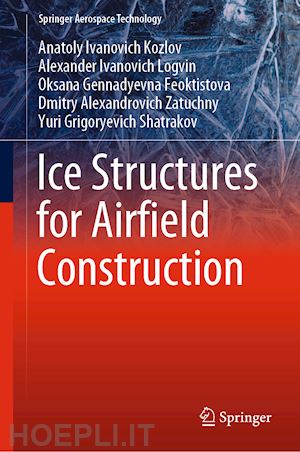
Questo prodotto usufruisce delle SPEDIZIONI GRATIS
selezionando l'opzione Corriere Veloce in fase di ordine.
Pagabile anche con Carta della cultura giovani e del merito, 18App Bonus Cultura e Carta del Docente
1. Modern methods of remote exploration of sea ice for the construction of ice airfields and the location of ground-based flight support facilities
1.1 Objectives and general principles of application of remote methods of studying the environment
1.2. Acoustic methods
1.3. Optical methods1.4. Active radar methods
1.5. Passive radar (radiometric) methods
1.6. The method of integration of active and passive radar sensing means in order to use the underlying surface to ensure aircraft flights
References for Chapter 1
2. Structure and composition of the sea ice cover
2.1. Types of sea ice and nomenclature of ice terms of the World Meteorological Organization. The possibility of using different types of ice sheets to support aircraft flights.
2.1.1. Formation and development of the ice cover. Initial ice forms
2.1.2. Annual ice
2.1.3. Two-year and long-term ice
2.1.4. Channels and divorces, wormwoods
2.1.5. Ice drifting islands and icebergs
2.2. Structure of the sea ice cover and dynamic processes, occurring in it
2.2.1. Forms of spatial structure and geometric characteristics of the ice cover
2.2.2. Cohesion and fragmentation
2.2.3. Distribution of ice thickness
2.2.4. Hummockiness
2.2.5. Characteristics of ice drift and compression
References for Chapter 2
3. Physical properties of ice, used to solve problems of civil aviation
3.1. Atomic-molecular structure of ice and phase diagram of sea ice
3.1.2. Dynamics and disruption of the structure of the crystal lattice of ice
3.1.3. Sea ice phase diagram3.2. Structural and genetic classification of ice
3.2.1. Classification of ice of natural reservoirs by N.V. Cherepanov. Possibility of use for aviation.
3.2.2. General classification of ice, proposed by the Ice Committee of the International Association for Hydraulic Research
3.3. The main characteristics of the physical state of sea ice and their seasonal variability
3.3.1. Ice temperature
3.3.2. Salinity
3.3.3. Density
3.3.4. Relative content of gas and brine in sea ice samples
3.4. Thermophysical properties
3.4.1. Thermal deformation of ice3.4.2. Thermal conductivity and thermal conductivity
3.4.3. Heat of melting and specific heat of sublimation
3.4.4. Heat capacity
3.4.5. Volumetric diffusion, condensation and evaporation
3.5. Mechanical properties3.5.1. Elasticity and internal friction of ice
3.5.2. Plasticity of ice
3.5.3. Ice strength. General provisions, terminology. Definitions, brief information about experimental studies
3.6. Seismoacoustic properties of ice, used to solve problems of civil aviation
3.6.1. Types of elastic waves in ice sheets and characteristics of their propagation3.6.2. Spectra of natural oscillations
3.7. Electrical properties of ice, used to solve problems of civil aviation
3.7.1. Speed of electromagnetic waves, characteristics of their absorption and reflection
3.7.2. Electrical properties of freshwater ice cover
3.7.3. Electrical properties of sea ice
3.8. Optical properties of ice, used to solve problems of civil aviation
3.8.1. Refraction, absorption, reflection and scattering of light by ice
3.8.2. Emissivity of ice
3.9. On the anisotropy of the physical properties of ice
References for Chapter 3
Anatoly Ivanovich Kozlov is Doctor of Physical and Mathematical Sciences, Honorary Master of Sciences and Engineering of the Russian Federation, Professor in the Department of Technical Operation of Radio-technical Equipment for Air Transport. He is the author of about 300 scientific works, including 21 monographs, 25 textbooks and 13 patents for inventions of a number of radio engineering tools.
Alexander Ivanovich Logvin is a professor, doctor of technical sciences. He graduated from Kiev State University in 1966 with a degree in Radiophysics. He defended his Ph.D. thesis at the Bauman Moscow Higher Technical School in the specialty Location and Navigation. He defended his doctoral thesis in 1987 at the Leningrad Academy of Civil Aviation in the specialties maintenance of air transport and navigation and air traffic management. Oksana Gennadyevna Feoktistova is Doctor of technical sciences, Associate Professor and Head of the Department of Computing Machines, Complexes, Systems and Networks at the Moscow State Technical University of civil aviation. She graduated from the Moscow Institute of Civil Aviation Engineers in 1988 with a degree in Electronic computing machines. She defended her Ph.D. thesis in 1997 at the Moscow State Technical University of civil aviation. Her research interests are in the areas of flight safety in air traffic control. Dmitry Alexandrovich Zatuchny is Doctor of technical sciences, Associate Professor and Professor in the Department of Computation Machines, Complexes, Systems and Networks at Moscow State Technical University of Civil Aviation. He is the author of more than 140 scientific works, including 5 monographs, 6 textbooks, 1 patent on an invention and 6 state registered computer programs. He was responsible for a number of research projects on ensuring the functioning of modern navigation systems in civil aviation aircraft and air traffic control. Yuri Grigorievich Shatrakov is Doctor of Technical Sciences, Russian Federation Honored Worker of Science, and Professor at the Academy of Technological Sciences of the Russian Federation. He has worked in the field of air navigation since 1963, and his interests focus on ground and on-board systems of radio navigation, instrumental landing, secondary radar, air traffic control systems, and training and simulation systems. He has published more than 400 scientific papers.










Il sito utilizza cookie ed altri strumenti di tracciamento che raccolgono informazioni dal dispositivo dell’utente. Oltre ai cookie tecnici ed analitici aggregati, strettamente necessari per il funzionamento di questo sito web, previo consenso dell’utente possono essere installati cookie di profilazione e marketing e cookie dei social media. Cliccando su “Accetto tutti i cookie” saranno attivate tutte le categorie di cookie. Per accettare solo deterninate categorie di cookie, cliccare invece su “Impostazioni cookie”. Chiudendo il banner o continuando a navigare saranno installati solo cookie tecnici. Per maggiori dettagli, consultare la Cookie Policy.